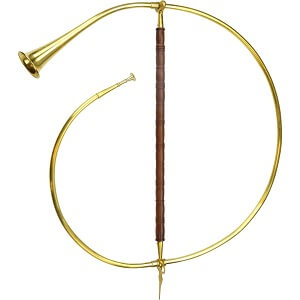Cornu
 Cornu, (Latin: “horn”), large metal horn of ancient Rome, used as a military and ceremonial instrument. It was about 11 feet (slightly more than 3 m) in length and had the shape of the letter G, with a crossbar brace that supported the instrument’s weight on the player’s shoulder. Two specimens survive from the ruins of Pompeii. Under the name tuba curva a version of the instrument was revived in France during the Revolution and was used by the composer André-Ernest-Modeste Grétry in his music for Voltaire’s interment in the Pantheon.
Cornu, (Latin: “horn”), large metal horn of ancient Rome, used as a military and ceremonial instrument. It was about 11 feet (slightly more than 3 m) in length and had the shape of the letter G, with a crossbar brace that supported the instrument’s weight on the player’s shoulder. Two specimens survive from the ruins of Pompeii. Under the name tuba curva a version of the instrument was revived in France during the Revolution and was used by the composer André-Ernest-Modeste Grétry in his music for Voltaire’s interment in the Pantheon.
In Ancient Rome the cornu was used in the army, but also in amphitheatres, during circus games and all kinds of ceremonies, such as funerals and processions. Typically, a cornu played together with a hydraulus, a water organ, to accompany the fights of the gladiators. This duet is pictured on a mosaic from the second-century Roman villa of Nennig near Trier (ill. 2). With their thunderous sound the cornu and hydraulus could drown out the racket of the immense amphitheatres, where the spectacles, so much enjoyed by the audiences of those times, were put on. With its powerful and ceremonious sound the cornu marked the fights and their preparations. A lost mural painting in Pompeii, only known thanks to a 19th-century watercolour (ill. 3), would suggest the gladiator himself played the cornu. As a rule, though, the cornicen was a musician dressed in the same attire as the judges in the arena.